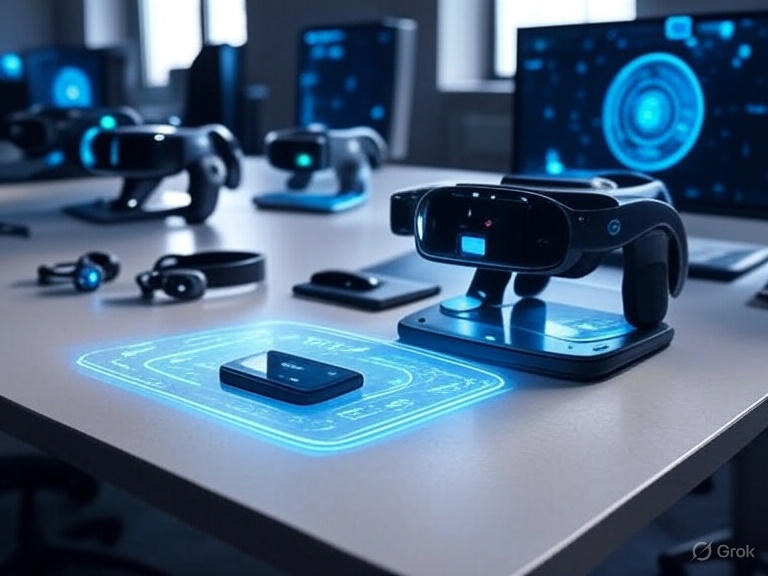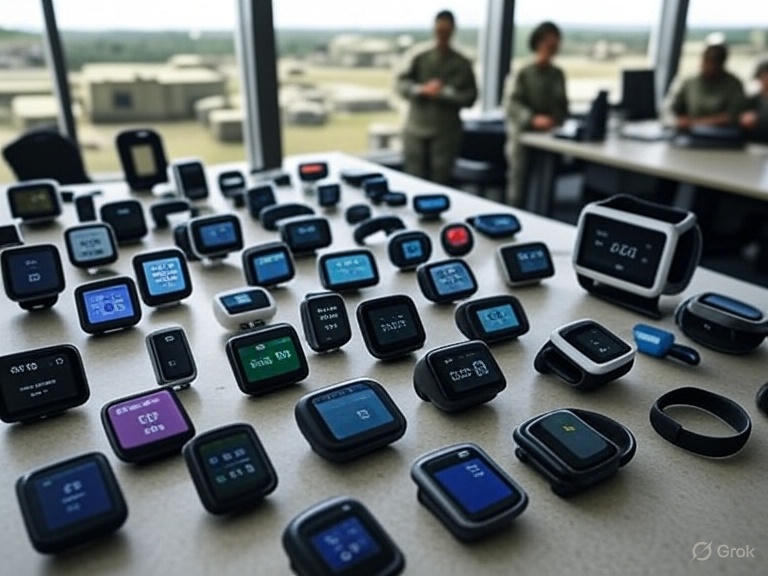Wearable health devices are small gadgets you wear to stay healthy. They track steps, heart rate, and sleep. These tools help soldiers train better and workers feel good. They are changing how the military and workplaces care about health. I’m Ramona P. Woodmansee, and I study health tools to keep people safe. This article shows how wearables work, why they matter, and how to use them well. Let’s see how these gadgets make life better.
What Are Wearable Health Devices?
Wearable health devices are like tiny helpers on your wrist or body. They check how much you move or sleep. For example, a smartwatch counts steps or shows if you slept well. These gadgets are easy to use and give health information fast. Some military units test them to help soldiers. Workers use them to stay active at their jobs.
These devices are special because they watch your health all the time. They show what your body needs, like rest or exercise. In pilot programs, soldiers train smarter. In offices, workers feel healthier. I study health tools and see how wearables help people every day.
Why Wearables Help Wellness
Wearables are great for keeping people healthy. They give you information to make smart choices. For example, if you don’t sleep enough, a wearable says to rest more. Soldiers use this to stay strong for missions. Workers use it to feel less stressed and work better.
These gadgets also help teams. In the military, leaders use wearable data to plan training. In workplaces, bosses make fun health contests. This makes everyone feel cared for. My research shows wearables are like a friend who helps you stay healthy. They change how we think about wellness.
Wearables in the Military: Stronger Soldiers
Some military units test wearable health devices in special programs to help soldiers train better. These gadgets track heart rate, sleep, and energy. For example, in the Army, soldiers wear rings to check how well they rest. This helps them stay strong for tough tasks. The Army also lets soldiers use their own smartwatches, like Garmin. This makes tracking health easy for all.
Wearables help in many ways. If a soldier’s heart rate is too high, the device says to slow down. This stops injuries before they start. For example, a soldier rests if their wearable shows they’re tired. But some devices don’t work in hot deserts or cold mountains. The military tried a ring called OuraRing, but DHA Cancels OuraRing Biometric Ring Solicitation because it had problems. After canceling the OuraRing plan, the military continues exploring other wearable options.
Keeping data safe is hard. Soldiers don’t want others to see their health information. The military uses strong passwords and safe apps to fix this. They also teach soldiers how to use wearables right. As someone who studies safety, I know these steps make wearables a big help for soldiers.
Wearables in the Workplace: Healthier Workers
In workplaces, many workers say wearable health devices help them feel healthier or more motivated. Companies give out bands like Fitbit to track steps. Workers join contests to walk more, like trying to get 10,000 steps a day. This makes work fun and keeps people moving. For example, a team might compete to see who walks the most.
Some wearables help with stress. A device called Cove vibrates softly to calm workers. This is great for busy days. Wearables also help bosses make health plans. If a worker doesn’t sleep well, the device suggests going to bed earlier. My work on health tools shows these gadgets make workers better at their jobs.
But there are worries. Some workers don’t want bosses to see their data. Others find devices tricky to use. Companies fix this by keeping data private with locks. They also teach workers how to use the gadgets. These steps make wearables a fun way to stay healthy at work.
How Wearables Work Every Day

Wearable health devices are easy to use every day. You put them on, and they start tracking. For example, a smartwatch buzzes if you sit too long. This reminds soldiers to move during training. Workers get alerts to stand up at their desks. These small nudges help people stay active.
The devices also show patterns. If a soldier sleeps badly for a week, the wearable warns them. A worker might see they’re stressed every afternoon. This helps them change habits, like resting more. I’ve studied how these tools give clear information. They make it simple to know what your body needs.
New Wearables in 2025
In 2025, wearable health devices are getting better. They have new tricks to help soldiers and workers. For example, some use smart tech called AI. AI can guess if a soldier might get hurt and tell them to rest. Workers get tips to avoid stress before it starts.
New wearables are comfy. Some are tiny rings or clothes with sensors. They don’t feel heavy or annoying. Batteries last longer, too. This is great for soldiers in the field or workers on long days. Workplaces use wearables for team games, like who can walk the most. Some offices even add yoga plans with wearables. My research shows these changes make health fun and easy.
Problems with Wearables
Wearable health devices have some issues. One problem is wrong information. For example, a device might say you ran when you didn’t. This can confuse soldiers or workers. Companies are fixing this by testing devices a lot. They use better sensors to make sure data is right.
Privacy is a big worry. Some worry that tracking health feels like spying. That’s why privacy and choice matter. Soldiers don’t want their health data shared. Workers don’t want bosses to know if they’re stressed. Safe apps with strong passwords help. Companies also let people choose what data to share. For example, a worker can hide their sleep data.
Some people find wearables hard to use. Older workers or soldiers may not like apps. Training classes make it easier. Companies also make apps with big buttons and clear words. My work on online safety shows these steps keep information private and devices easy to use.
How to Fix Wearable Problems
We can fix wearable problems to make them better. For wrong data, companies test devices in tough places, like jungles or offices. They use new tech to make sensors smarter. This means soldiers get true heart rate data. Workers see real step counts.
For privacy, companies use safe systems. They lock data so only you see it. In the military, special rules keep health information secret. Workers can choose to share data or not. Training helps, too. Soldiers learn how to set up their devices. Workers get classes on using apps. I study safety and know these steps make wearables trustworthy.
If devices are hard to use, simple designs help. For example, a watch with one button is easier than a tricky app. Companies also make guides with pictures. This helps older workers or new soldiers. These fixes make wearables work for everyone.
Tips to Use Wearables Safely
You can use wearable health devices the right way with these tips:
- Check your data every day to learn about your health.
- Clean your device so your skin stays happy.
- Charge it every night so it works all day.
- Ask a friend if the app is confusing.
- Use a strong password to keep your data safe.
These tips help soldiers and workers stay healthy. My years of studying health tools show these steps are easy and work well. For example, cleaning your device stops skin rashes. Charging it means you never miss data. You can also update apps to keep them safe.
Real Stories of Wearables Helping
Wearables help real people every day. In the Army, a soldier named Jake used a smartwatch to track his sleep. He saw he wasn’t resting enough. He changed his bedtime and felt stronger for missions. This shows how wearables help soldiers stay ready.
In an office, a worker named Sarah got a Fitbit from her boss. She joined a step contest with her team. She walked more and felt healthier. Her team won the contest, and they got prizes. This made work more fun. My research shows stories like these happen a lot.
Another example is a device called Whoop. Soldiers use it to check how hard they train. It tells them when to rest so they don’t get hurt. Workers use Whoop to see if they’re stressed. Some offices use Whoop for yoga plans to help workers relax. These stories show why wearables are so helpful.
Why Wearables Are the Future
Wearable health devices are making military and workplace wellness better. They help soldiers stay strong for missions. Many workers say they feel healthier or more motivated. New tech, like AI and comfy designs, makes them even better. There are problems, like privacy or wrong data. But we can fix them with safe apps and better sensors.
As Ramona P. Woodmansee, I’ve studied health tools and online safety for years. I’ve seen how wearables help people make smart choices. They give you power over your health. Whether you’re a soldier or a worker, these devices can change your life. Try one today and see how it helps. Share your story in the comments below!
Disclaimer: This article is for informational purposes only. It does not replace professional medical or health advice. Always talk to a doctor or expert before using wearable health devices or making changes to your health routine. The author is not responsible for any results from using these devices.
